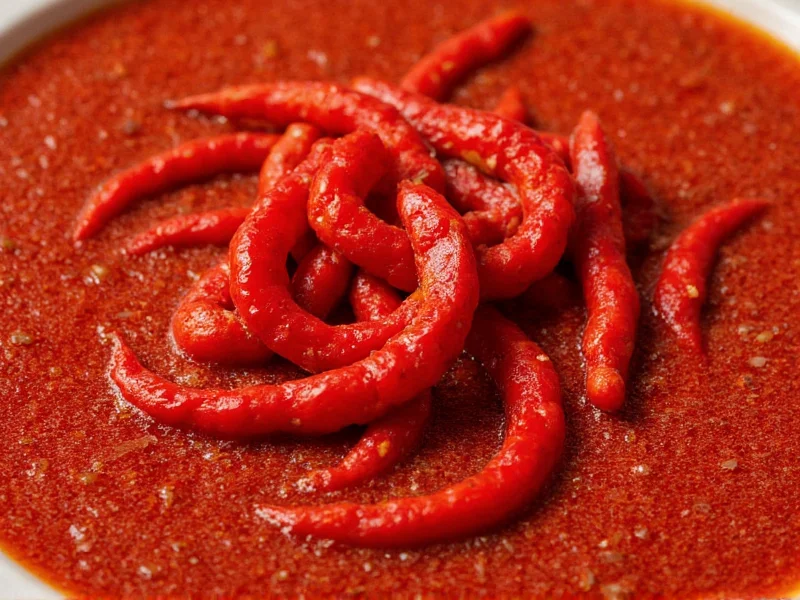When exploring is chamoy spicy, it's essential to understand this Mexican condiment's complex flavor profile. Chamoy originated from Asian preserved fruits adapted through Chinese-Mexican culinary fusion, evolving into the versatile sauce, powder, and candy forms popular today. While chili peppers provide its characteristic warmth, chamoy's signature taste comes from a harmonious blend of ingredients that create a multifaceted sensory experience.
What Exactly Is Chamoy?
Chamoy refers to both a category of Mexican snacks and the sauce used to flavor them. Traditional chamoy starts with pickled fruit—often apricots, plums, or mangoes—preserved in a mixture containing:
- Chili peppers (providing heat)
- Vinegar (contributing sourness)
- Salt (adding savory depth)
- Sugar or fruit syrup (balancing with sweetness)
- sometimes tamarind (enhancing complexity)
The resulting product ranges from liquid sauce to thick paste to dry seasoning powder, with spiciness levels varying across this spectrum. Understanding what makes chamoy spicy requires examining its core components and preparation methods.
Decoding Chamoy's Flavor Components
Chamoy's unique appeal comes from its balance of four primary taste elements. Unlike single-note hot sauces, chamoy delivers a layered experience where no single flavor dominates:
| Flavor Element | Primary Ingredients | Typical Intensity |
|---|---|---|
| Sweet | Sugar, fruit syrups, sometimes honey | Moderate to High |
| Sour | Vinegar, tamarind, citrus | Moderate |
| Salty | Salt, sometimes soy sauce | Moderate |
| Spicy | Chili peppers (arbol, guajillo, de árbol) | Low to Moderate |
Factors That Determine Chamoy's Spiciness Level
Several elements influence how spicy chamoy tastes, explaining why chamoy flavor profile varies across products:
Chili Pepper Selection
The type and quantity of chilies used directly impact heat level. Common varieties include:
- Guajillo: Mild heat (2,500–5,000 SHU) with berry-like notes
- Arbol: Medium heat (15,000–30,000 SHU) with sharp, nutty flavor
- De árbol: Similar to arbol but slightly milder
- Chipotle: Smoky with moderate heat (2,500–8,000 SHU)
Most commercial chamoy uses milder chilies like guajillo as base, keeping overall heat approachable. Artisanal or regional varieties might incorporate hotter peppers for bolder profiles.
Preparation Method
Traditional chamoy starts with pickled fruit, where the chilies infuse gradually over time. This slow extraction creates a more balanced heat than sauces made with direct chili powder addition. Industrial production sometimes uses chili extracts for consistency, which can result in sharper, less nuanced spiciness.
Regional Variations
Mexican regions have distinct chamoy styles:
- Central Mexico: Typically milder with pronounced sweet-sour balance
- Northern Mexico: Often features more noticeable heat
- Street vendor versions: Can range from mild to quite spicy based on vendor preference
Comparing Popular Chamoy Products
When evaluating how spicy is chamoy compared to other sauces, consider these common products and their heat characteristics:
| Product Type | Spiciness Level | Flavor Notes | Best For |
|---|---|---|---|
| Liquido (liquid) | Low-Moderate | Bright, tangy, balanced | Dipping fresh fruit |
| En polvo (powder) | Moderate | Concentrated, salty-sweet | Seasoning snacks |
| Pasta (thick sauce) | Variable | Rich, complex, fruit-forward | Tamarind candies |
| Industrial brands | Consistently mild | Simplified flavor profile | Mass-market appeal |
Chamoy vs. Other Mexican Condiments
Understanding chamoy spiciness compared to Tajín or Valentina helps contextualize its heat level:
- Tajín Clásico: Primarily chili-lime salt with mild heat (similar to mild chamoy)
- Valentina Salsa: Noticeably hotter than most chamoy (uses puya chilies)
- Chamoy: More complex flavor with less emphasis on pure heat
- Magical: Similar concept to chamoy but often sweeter and milder
While hot sauce enthusiasts might find standard chamoy relatively mild, those sensitive to spice should note that some artisanal varieties can deliver a significant kick. The mild chamoy vs spicy chamoy distinction largely depends on the specific product and regional recipe.
Using Chamoy Based on Your Spice Preference
Whether you're exploring is chamoy hot or sweet for culinary experimentation, consider these usage tips based on heat sensitivity:
For Low Spice Tolerance
- Choose liquid chamoy over powder (powders concentrate flavors)
- Look for products labeled "suave" (mild)
- Dilute with lime juice or water when using as sauce
- Start with small amounts and adjust to taste
For Medium Spice Tolerance
- Most commercial chamoy products will suit your palate
- Try chamoy-drenched fresh fruit (mango, pineapple)
- Use as a base for micheladas or spicy margaritas
- Combine with tamarind candies for balanced sweet-heat experience
For High Spice Tolerance
- Seek artisanal or regional varieties from Mexico
- Look for products specifying hotter chilies like arbol
- Mix chamoy with Valentina or other hot sauces
- Try chamoy-infused pulparindo candies for intense flavor
Final Considerations on Chamoy's Spiciness
When answering is chamoy spicy, the most accurate response acknowledges its variable nature. Unlike dedicated hot sauces designed primarily for heat, chamoy serves as a flavor enhancer where spiciness plays a supporting role. Its magic lies in the interplay of sweet, sour, salty, and spicy elements—with the heat level carefully calibrated to complement rather than dominate.
As chamoy gains global popularity beyond Mexican cuisine, manufacturers increasingly tailor products to local palates. This means imported versions sold internationally often feature milder profiles than those found in Mexico. When shopping, check ingredient lists for chili types and consider starting with small quantities to assess your personal tolerance for how spicy chamoy really is in different formulations.











 浙公网安备
33010002000092号
浙公网安备
33010002000092号 浙B2-20120091-4
浙B2-20120091-4